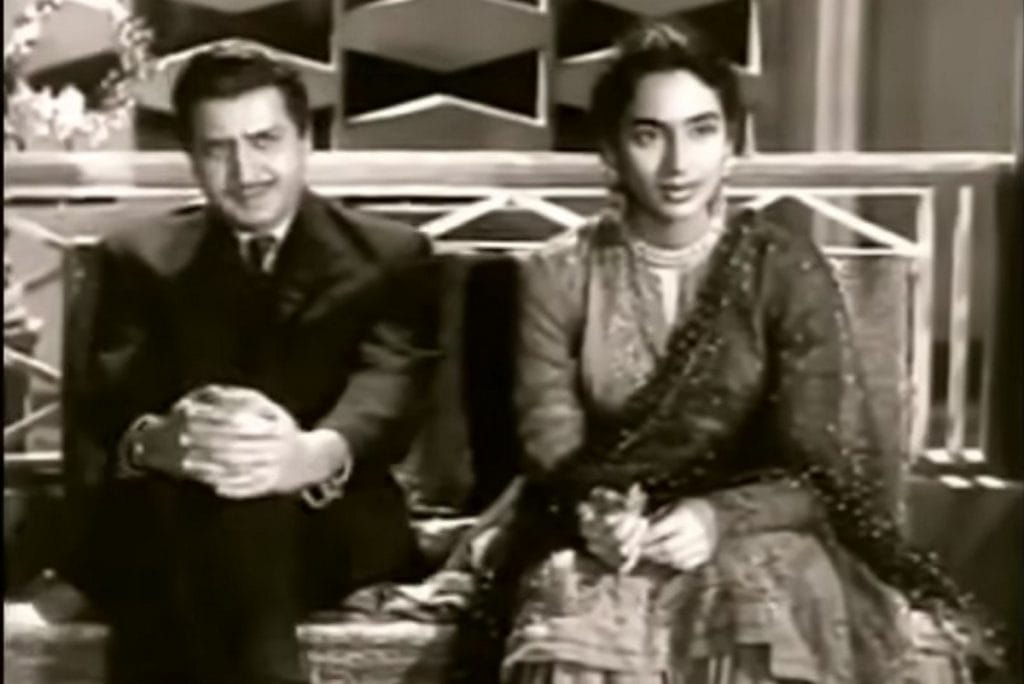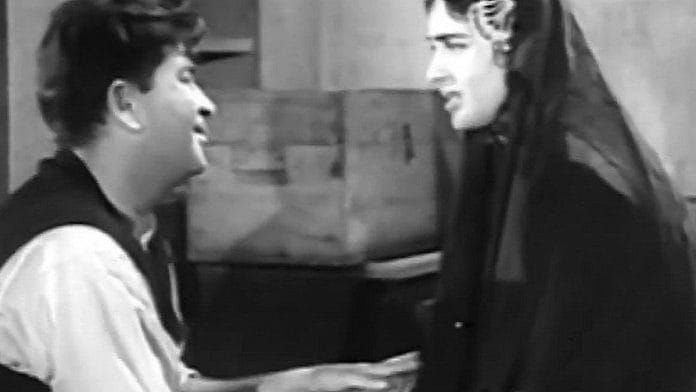The genre of the “Muslim social” carved a niche for itself in Indian cinema during the 1950s and 60s. These films often put nawabi culture front and centre— mushairas, qawwalis, shararas, and courtly romance wrapped in poetic Urdu.
Films like Mere Mehboob (1963), with its reverence for tehzeeb, or Chaudhvin Ka Chand (1960), with its treatment of parda and parampara, were as much about aesthetic as they were about the romantic or familial dramas at their core.
But Dil Hi Toh Hai (1963), directed by CL Rawal, and starring Raj Kapoor and Nutan, stands as a compelling outlier in this tradition.
Though unmistakably rooted in the Muslim social world — complete with a sprawling haveli, Urdu couplets, and nods to cultural sophistication — the film gently pushes against its conventions.
Dil Hi Toh Hai is a tale of mistaken identity, class divisions, and love caught in the crosshairs of family legacy.
Chand (Raj Kapoor) is taken in by a wealthy nawab’s household under mysterious circumstances. He meets another nawab’s spirited daughter, Jameela (Nutan), and the two gradually fall in love.
Shekhu (Pran) plays the unwanted third wheel in the love story, trying everything to win Jameela over and failing.
Apart from Shekhu, their romance runs into another barrier: social class. How can the son of a household worker marry into a wealthy, noble family?
When Jameela’s father, Khan Bahadur, asks Chand, “Tumhara khandan kya hai?” (What is your lineage?), he replies, “Insaniyat” (humanity). To “Tumhari jaaydaad?” (Your wealth?), he answers, “Sharafat” (decency).
But the truth about Chand’s identity, revealed in the climax, turns everything on its head and leaves the families in shock.
Also Read: Ek Chadar Maili Si isn’t an easy watch. Hema Malini plays a woman trapped by tradition
Jameela: the modern Muslim woman
If Raj Kapoor’s Chand is a familiar iteration of the underdog hero—sensitive, upright, morally impeccable—Nutan’s Jameela is a revelation.
Unlike her cinematic cousins in Mere Huzoor or Chandni Chowk, Jameela is neither coy nor overly delicate. She’s vocal, outspoken, opinionated, and unafraid to challenge the men around her.
Nutan brings to Jameela a striking combination of grace and grit.
She engages in verbal duels, expresses her thoughts without hesitation, and actively participates in decisions about her own life. She’s not just a passive love interest.
This is a quiet but radical departure from the submissive stereotype of the “good Muslim daughter”.

Even when Jameela argues with her elders or stands up to societal expectations, it’s not with melodrama, but with intelligence and composure.
Her character feels refreshingly modern—even radical—when viewed against the template of Muslim heroines of the era. Her subtle sense of humour adds moments of laughter to the film.
Additionally, the relationship between Chand and Jameela is marked more by mutual respect and wit than by languishing love songs under moonlit balconies.
In classic Muslim socials, romance often unfolded through longing glances and poetic exchanges. But here, there is humour and heat in their interactions, speaking to an intellectual compatibility rarely seen in the genre’s romantic pairs.
Chand and Jameela tease and challenge each other. Their chemistry is built on dialogue and shared ideals, not just shayari.
It’s a shift from idealised love to something more grounded and modern — a relationship where both partners are framed as intellectual and emotional equals.
Family status was often a key conflict in Muslim socials, but the films rarely questioned the system itself. Dil Hi Toh Hai does.
The mystery of Chand’s parentage becomes a central plot point. Raised without knowledge of his real family, his love for Jameela creates tension — not because he lacks character, but because he lacks pedigree.
However, the film ultimately challenges it by focusing on Chand’s moral and intellectual worth over his background.
The message is clear: nobility is not in blood, but in values.
Also Read: Doosara Aadmi tackled emotional infidelity before Bollywood had a language for it
Roshan’s magical touch
Music is the most memorable element of Dil Hi Toh Hai.
Visually and musically, the film still embraces the trappings of the genre. There are flowing anarkalis, delicately draped dupattas, and the obligatory ghazal and qawwali sequences, most notably in Laga Chunari Mein Daag and Nigaahein Milane Ko Jee Chahta Hai.
Roshan’s music, always more nuanced than bombastic, threads classical ragas into compositions that feel like part of the story rather than set pieces.
His brilliance is especially dazzling in Tum Agar Mujhko Na Chaho. Sung by Mukesh, the song captures the ache of unrequited love in a melody that lingers long after the film is over.
It may not be the most celebrated film of its time, but Dil Hi Toh Hai stands out for the way it defies conventions.
It isn’t a revolutionary film, but a transitional one—still rooted in the aesthetics of elite Muslim society, yet pulling away from its limitations.
Nutan’s Jameela, especially, remains one of the genre’s most striking heroines, representing a certain ‘modernisation’ that would become more prominent in the decades to come.
Views are personal.
(Edited by Asavari Singh)






